CC event launches new partnership between
NIH and Howard University students
 |
Dr. Keith Hunter, CC anesthesiologist, talks with Howard University students Montreal McMorris (left) and Coretta Tillery (right) who, along with 18 of their fellow classmates, visited the CC as a part of a new mentor-partnership between NIH and the university.
|
In an effort to encourage minority students to consider a career in scientific research, a team of three individuals—two from NIH and one from Howard University—developed a new program designed to introduce undergraduate students to researchers who could mentor them. It was envisioned as a way for successful scientists to “reach back” and help students.
Walter Jones, CC deputy director for management and diversity and one of the Reach Back program’s three founding partners, says his personal mission is to help students fulfill their dreams. “I am committed to creating an environment of increased diversity for the next generation of researchers.”
Jones and Vi Black, program manager for trainee activities and outreach at NCI, teamed up with Nancy Greer-Williams, program director for the Howard University Science, Engineering and Mathematics initiative (HUSEM)—a National Science Foundation-funded program for underrepresented and primarily African-American students—in summer 2005 to discuss the mentoring program. Over the following months, discussions turned into reality, eventually resulting in a Nov. 10 event that brought researchers and students together.
Researchers from various NIH institutes spent the evening sharing their personal stories with students, describing the challenges and victories they encountered while pursuing their own dreams.
Greer-Williams envisioned the event as a chance for those who had found professional success to reach back and influence the life of a younger individual who was starting out on that journey. “The people who spoke were transparent with the students—they spoke from their hearts,” she says. “They spoke as if they understood that at one point it could have been them on the other side of that table. Our students were not just inspired, but motivated.”
Following the lecture period, students broke into small groups to meet with researchers, allowing the students the one-on-one time they were most excited about. In previous visits to NIH, Howard University students would tour laboratories and facilities in a large group, but would often leave disappointed. “They would see these people who had found success in their careers, in these incredible labs, but our students would leave still asking, ‘How do I become that type of person?’ What they needed was a mentor—someone who could give them the step by step,” Greer-Williams explains. Both she and Jones credit the “fireside chat” time between researchers and students with the increase in Howard University students’ applications for summer internships and in some cases, even a jump in the participants’ grade point averages.
“With most research internships, students are encouraged to find a mentor or personal contact and work with that person to secure a position on a research team, but these students have not been given that same exposure,” Jones says. “Because of this program, they now have a name and a face to work with. They are not shooting out in the dark.”
“Everybody in that room reached back and touched a student,” Greer-Williams adds.
Jones and Greer-Williams hope the success of the Nov. 10 event signifies a healthy interest of both NIH researchers and Howard University students to continue the partnership and build future mentor-relationships.
Back to Top
Gingerbread house winners on a sugar high from big wins—competition fiercer than ever
From the pretzel fences, to the bubble gum roofs, to the almond masonry—the 2005 Gingerbread
|
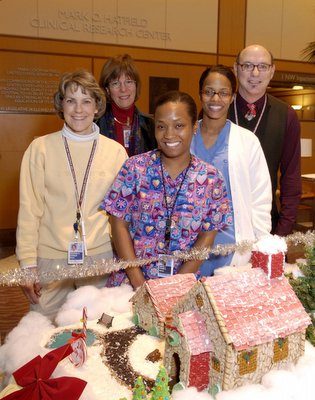
|
1st Place
Pictured with Dr. Clare Hastings, nursing chief, are (left to right) winners Debbie Rawson, Nikkia Powell, Stacy Barley and Richard Runnells of 1 NW day hospital. Not shown are Heather Ballard, Kathleen Beville and Donna Gwyer. They won the top prize for their country-style, stone cottage covered in sliced almonds. “Our patients inspired us,” said Runnells. “They wanted us to build a first place house to represent their progress.”
|
House Decorating Contest entries were more elaborate than ever. One group even added a barn to their architecture plans, complete with shredded wheat for hay. And while the health factor of wheat could have lost them a few points; because, as everyone knows, gingerbread houses are all about the sugar—that group walked away with a respectable 2nd place.
The December contest was open to all Clinical Center departments/units. The decorated treats were displayed in the CC atrium where patients, visitors and employees viewed the competition and cast their votes for the winners.
First place went to the entrants from the 1 NW day hospital, second place was awarded to the 5 SE inpatient unit, and the 1 NW inpatient unit designers walked away with third place.
“Last year there were 16 houses, this year there were 28,” said Ann Marie Matlock, clinical manager of 5 SE. “The competition was fierce, and we saw some very creative ideas. You could see a lot of time was put into each house.”
Nicole Yanjanin, a member of 1 NW’s third place team, described the many pieces that went into their gingerbread village—complete with ice skaters and carolers. “Our goal was to make sure everything we used was edible,” she said. “Even the people were made out of lollipops.”
The popularity of the Clinical Center’s gingerbread house contest, which was initiated by CC nurses two years ago, surprised even Matlock, who expected only a few hundred votes to be cast. “We had no idea there would be more than 1,000 votes,” she said.
“Seeing the smiling faces of everyone who came to see the display made it well worth the time and effort required to put this event together,” Matlock added.
At the conclusion of the competition, the gingerbread houses were donated to the Children’s Inn and the Safra Family Lodge for display.
To view photos of the other gingebread competition winners, click here.
—John Iler
Back to Top
Santa and Redskins cheerleaders bring holiday joy to CC patients
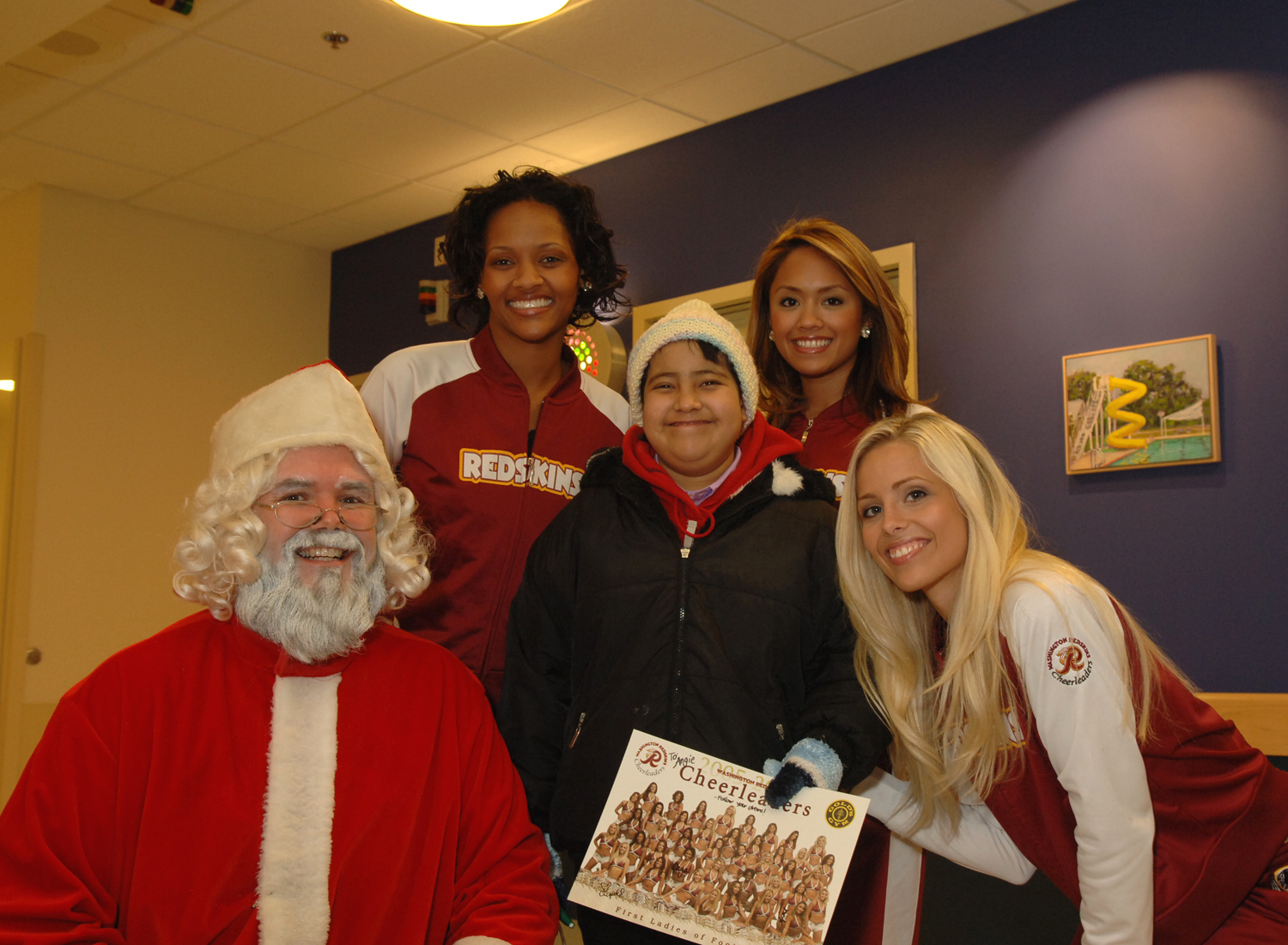 |
Santa Claus and the Washington Redskins cheerleaders bring some holiday cheer to Clinical Center patients, including Angie Perez Ochoa (center). Each year, the NIH police and fire departments collect donated toys and arranges for Santa to bring them to patients in need of a holiday surprise.
|
The NIH police and fire departments received more than 1,000 toys from NIH employees for their ninth annual Toys to Share Because We Care program. Nearly 400 employees donated dolls, action figures, art kits, stuffed animals and games to children throughout the Clinical Center.
Members of the police and fire departments escorted some very special visitors through the Clinical Center during the holiday season—Santa Claus and the Washington Redskins cheerleaders. The jolly man in red and his entourage were on hand to distribute the collected gifts to children and adults who were hospitalized during the holidays.
“It’s amazing to see the joy on the faces of the families as they take part in the event,” said Lt. Lawrence Brown. “And I know the police and firemen who volunteer enjoy the event as well.”
Back to Top
Speaker outlines how hospitals can improve health care
Meeting need is the essence of quality, said Dr. Donald Berwick, president and CEO of the Institute for Healthcare Improvement, during his Jan. 11 Great Teachers lecture at the CC. The search for quality improvement in health care—making things better—begins by understanding what the needs are, he told the standing room only crowd, and acting on it.
 |
Great Teachers lecture speaker Dr. Donald Berwick explains how his organization is working to improve health care and eliminate needless deaths.
|
Health care, Berwick explained, should be safe, effective, patient centered, timely, efficient and equitable—the six dimensions of health care ‘needs’ described in the Institute of Medicine’s 2001 report, “Crossing the Quality Chasm.” Health care is effective, he said, “when we match what we do to the known science base. Timeliness means not making anybody wait—not care givers or patients. Efficiency is not wasting money or time or ideas or spirit.”
These aspects of health care translate to what Berwick calls the ‘no-needless’ list. “The health care system I want and envision has no needless deaths, no needless pain, no helplessness on the part of the workforce, the family or the patient, no unwanted waiting, no waste—for anyone. That’s where we are headed.”
His organization’s 100K lives campaign (read more at http://www.ihi.org) aims to save lives by implementing changes in patient care proven to prevent avoidable deaths. The campaign’s charge is one that other programs aimed at improving health care can use—change processes, trust the work force, use the science, and make change the norm, not the exception.
—Sara Byars
Back to Top
Clinical bioethics team wins research protection award
The Department of Clinical Bioethics won a 2005 Award for Excellence in Human Research Protection for their work in promoting the well being of people who participate in clinical research. Researchers in the clinical bioethics department were recognized for their innovation in establishing a framework and benchmarks for the ethical evaluation of protocols.
The CC team synthesized and organized guidance from existing codes and guidelines into a comprehensive and systematic set of principles that researchers and institutional review board members could use to guide their research. This framework of principles was described in two articles—one that was published in the Journal of the American Medical Association in 2000 and the other in the Journal of Infectious Diseases in 2004.
“We have heard from institutional review boards from several other countries that tell us they use our framework to evaluate their research proposals,” said Dr. Christine Grady, head of the department’s human subjects research section, who worked on both articles with her bioethics colleagues Dr. Ezekiel Emanuel, department chair, and Dr. Dave Wendler, head of the department’s vulnerable populations unit.
The Health Improvement Institute—a nonprofit organization dedicated to improving the quality and productivity of health care—created the research protection awards. The Office of Human Research Protection in the Department of Health and Human Services was the founding sponsor of the awards program.
Back to Top
CC-ers invited to lunchtime series to learn more about ongoing research
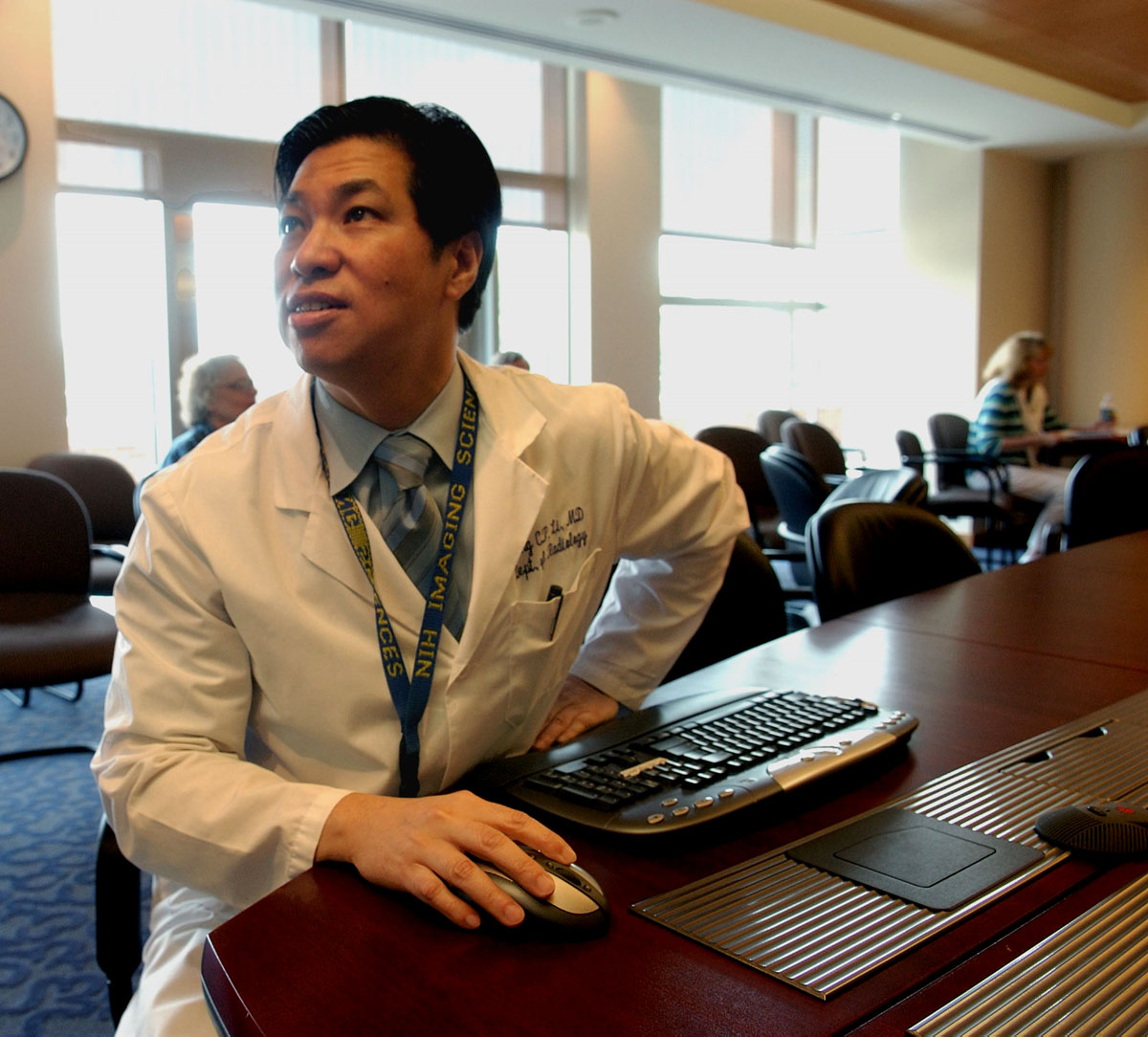 |
Dr. King Li, CC associate director for radiologic and imaging sciences, described how his team could send diagnostic and treatment molecules to specific places in the body and show that they have arrived with the use of fluorescent tracers. In addition, Li demonstrated how another imaging tool, a high-intensity ultrasound, that provides the right “drill” to make a small hole in a tumor, releasing pressure long enough to allow a targeted drug, or gene, to enter. Dr. Li presented his brown bag lecture on July 22.
|
Learn more about CC research during the ‘brown bag’ lunch series that continues noon-1 p.m. on Feb. 3 in the Medical Board Room on the 4th floor of the Hatfield Center (4-2551).
“This lunchtime series offers a closer look at the extraordinary work done here,” said Dr. John I. Gallin, CC director, who initiated the program last summer.
February’s speaker will be Dr. Henry Masur, chief of the Critical Care Medicine Department. He will discuss “The HIV Program in the Clinical Center: Two Decades of Accomplishment.” On Friday, May 5, Dr. Gwenyth Wallen, chief of nursing research and practice development service, Nursing and Patient Care Services, will speak on “Building a Program of Interdisciplinary Research in Health Disparities and Vulnerable Populations.”
The series has also included lectures by Dr. Gallin, who discussed his long-term research on inherited immune deficiencies; Dr. Ronald Neumann, chief of the Nuclear Medicine Department, who spoke on nucleic acids as radiopharmaceuticals; Dr. David Henderson, CC deputy director for clinical care, who addressed preparations for a possible influenza pandemic; and Dr. Thomas Fleisher, chief of the Department of Laboratory Medicine, who shared new insights into cell death pathways that result in ALPS (autoimmune lymphoproliferative syndrome), a disease discovered here at NIH.
Space is limited to the first 40 arrivals. For more information on upcoming brown bag lectures, contact Patricia Piringer, special assistant to the CC director, at (301) 402-2435.
—Linda Silversmith
Back to Top
A message from CC Director John I. Gallin
For the Clinical Center, 2005 was an extraordinary year. We moved into the new Mark O. Hatfield Clinical Research Center and opened a wonderful facility for patients and their families, the Edmond J. Safra Family Lodge. Patient activity peaked and new research programs were initiated despite tight fiscal times.
As the summer ended, Hurricanes Katrina and Rita tested our resolve and commitment in unprecedented ways. With compassion, creativity and dedication, Clinical Center staff developed and implemented innovative responses and willingly worked around the clock to help those in need.
A tragedy in December brought another challenge for us. A patient scaled the eight-foot barrier on the seventh floor of the atrium and fell to his death in what the medical exam-iner has ruled a suicide. It was a personal tragedy for the patient’s family and for those of us who consider all our patients members of the CC family. This very sad event is being thoroughly reviewed. What we learn will shape decisions we make about potential changes to our physical environment or other aspects of patient care and safety. Our commitment is to ensure a secure environment for everyone here.
As we begin a new year, please take a few minutes to reflect on what we accomplished together in 2005. The Clinical Center is an important resource for the nation—truly a house of hope—and the work you carry out here makes a difference in the lives of people throughout the world every day.
—John I. Gallin
Clinical Center Director
Back to Top
Hilda Cardona retires after 32 years of CC nursing
Though she has always worked the night shift, nurse Hilda Cardona has brought plenty of sunshine to her patients and colleagues throughout her 32 years of service at NIH. She has worked on a variety of nursing units, most recently on 5 NW, and has continually gone above and beyond her work responsibilities to provide the highest level of care.
The theme of Cardona’s life and career has been giving the gift of life to others—whether giving blood (she has donated more than 8 gallons at the Clinical Center Blood Bank) or bringing babies into the world as a nurse midwife during her early nursing days in her native Puerto Rico.
In 1969, Cardona graduated with a diploma in nursing from the Missionary School of Nursing at Antillian College in Mayaguez, Puerto Rico, and began working as an OB-nursery nurse at Bella Vista Hospital in Mayaguez. She later obtained a government grant to attend midwifery school in San Juan and was assigned by the Puerto Rican government to work as a nurse midwife in Corozal for two years where she delivered more than 300 babies.
In 1973, a CC nurse recruiter went to Puerto Rico to recruit Hispanic nurses. Cardona was one of five nurses who accepted and left her island home to move to Maryland. For ten years, Cardona lived in building 20, which at the time was on-campus, apartment housing for NIH nurses, doctors and visiting scientists. The Center Drive building, which opened in 1954, was demolished in 1997 to make room for the CC’s expansion.
She first worked on the 12 East endocrine unit from 1973 to 1975, then the pediatric oncology laminar flow and bone marrow transplant (BMT) 2B South unit for 13 years. From 1986 to 1992, she worked on the 12 West HIV unit, followed by 13 years on endocrine units 10 West and 8 West. During the February 1979 blizzard, Cardona worked 48 hours straight to care for her patients on the BMT unit, walking back and forth from her NIH apartment to cook and deliver food for the patients and for the only doctor and nurse on duty with her.
Cardona was one of five 8 West nurses who helped to create the first endocrine nurses’ society and she has been active in helping to care for many patients with Hermansky-Pudlak Syndrome (HPS). She was the only nurse on the multi-disciplinary CC team who first surveyed a 4-H camp in Front Royal, Va., that would become Camp Fantastic and later Special Love Camp for pediatric patients in the D.C. metropolitan area. Cardona also volunteered her time and talents at the Children’s Inn for 18 months following its opening while continuing to work nights.
After retirement, Cardona will return to the CC as a patient educator and volunteer Spanish-English interpreter. She also plans to travel, including a month-long cruise and cross-country train trip with her sister and two other retired CC nurses.
—Louise Canada, Nurse Historian,
Nursing and Patient Care Services
Back to Top
Employees honored at CC Director’s Award Ceremony
“Today, we will recognize those staff members whose contributions have helped us achieve the successes of the past year,” writes Dr. John I. Gallin, CC director, in the annual CC Director’s Award program. “These individuals represent the leaders, staff workers, contractors, and institute colleagues who have worked with dedication to make the Clinical Center a better place.”
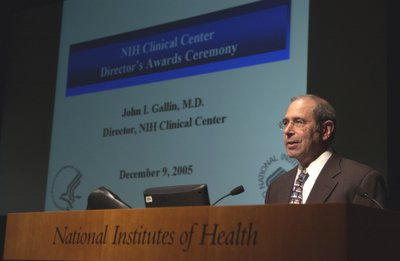 |
Dr. John I. Gallin gives the annual director’s address before congratulating each of the 89 CC Director’s Award recipients at the Dec. 9 awards ceremony.
|
On Dec. 9, a total of 89 CC employees were honored at the NIH Clinical Center 2005 Director’s Annual Address and Awards Ceremony for their contributions to NIH.
Here are the names of the 2005 CC Director’s Award recipients:
ADMINISTRATION
Sharon D. Adams, Department of Transfusion Medicine; Sara R. Byars, Office of the Director; Kelly Byrne, Critical Care Medicine Department; Marion Danis, Clinical Bioethics Department; Robert DeChristoforo, Pharmacy Department; Hillary Fitilis, Office of the Director; David Folio, Nutrition Department; Peter Herscovitch, Positron Emission Tomography Department; Patricia Kvochak, Office of the General Counsel, NIH; Amy L. McGuire, Foundation for the National Institutes of Health; Lynda Ray, Office of Administrative Management; Michael Sandifer, Materials Management Department; Carolyn Somers, Nursing and Patient Care Services
Edmond J. Safra Family Lodge Group
Margo Bradford, Operations Manager; Annie Harrison, Front Desk Clerk; Dilcia Stephens-Medley, Program Support Specialist; Jan Weymouth, Executive Director; Ellen Williams, Guest Relations Manager
Housekeeping & Fabric Care B-2 Crew
Joseph F. Cowling, David T. Crawford, Clemmons Dickens, Donnie R. Dunn, Charlie G. Grant, Jr., John L. Hall, Mark C. Henderson, Richard E. Johnson, Curtis E. Lumsden, Michael Saunders, Laura Ann Tabron
Housekeeping & Procurement Transition Team
Ann Argaman, Office of Purchasing and Contracts; Betty Hiller, Office of Administrative Management; Lynda Johnson, Office of Purchasing and Contracts; Juanita Coleman and Lucius Stewart, Housekeeping and Fabric Care
Katrina Response Coordinators
Elaine Ayres, Office of the Director; Pierre Noel, Department of Laboratory Medicine
ProtoType Team
Brian Chamberlain and Philip Lightfoot, Medical Record Department
JESSE FERGUSON CUSTOMER SERVICE
Tony Barnes, Sr., Department of Clinical Research Informatics; Davida Cummings and Christopher J. Howard and Tammy Moore, Nursing and Patient Care Services; Nyna Konishi and Lula Russell, Office of Administrative Management; Debrean A. Loy, Department of Transfusion Medicine; Angela Michelin, Hospital Epidemiology Service; William Phillips, Office of Financial Resource Management
NIH OD Workforce Relations
Tricia D. Moore and Gwen F. Platt, Office of Human Resources, NIH
MENTORING
Virginia Daine, Nursing and Patient Care Services
PATIENT CARE
Sara Bergerson, Nutrition Department; Dirk Darnell and Myra Woolery, Nursing and Patient Care Services; Penny Friedman, Office of the Director; Li Li, Department of Laboratory Medicine; Douglas Rosing, NHLBI; Ann Sheridan, Department of Laboratory Medicine; Bradford Wood, Diagnostic Radiology Department
Pre-Anesthesia Clinic Implementation Team
Christine Choi, Juanita Ellis, Margaret Fessler, Janice Haggerty, Claudette Hardy, Mary Lishewski and Nancy Muldoon, Department of Anesthesia and Surgical Services
QUALITY OF WORKLIFE/DIVERSITY
Lacey Gholson, Office of Administrative Management; Pamela Koviack and Migdalia Rivera-Goba, Nursing and Patient Care Services
SCIENCE
Rebecca Ann Parks, Rehabilitation Medicine Department; Scott R. Penzak, Pharmacy Department; Alan T. Remaley, Department of Laboratory Medicine; Gwenyth Wallen, Nursing and Patient Care Services
STRATEGIC INITIATIVES
Karen Kaczorowski and Lomar Yap, Nursing and Patient Care Services; Joyce Yarington, Department of Clinical Research Informatics
Day Hospital Intensity Working Group
Nursing and Patient Care Services
Georgia Cusack, Kathryn Feigenbaum, Donna Gwyer, Donna Hardwick, Antoinette Jones-Wells, Marsha Moore, Lori Purdie, Barbara Quinn
TEACHING/TRAINING
DeNedra McPherson, Office of the Director; Debra Parchen, Ann Peterson and Kristine Simpson, Nursing and Patient Care Services; Beth I. Solomon, Rehabilitation Medicine Department; David Wendler, Clinical Bioethics Department
PATIENT SAFETY CHAMPION AWARD
3-East Nursing and Patient Care Team
Keith Baptiste, Gail Butterworth, Andre Caple, Kim Cox, Nancy Day, Patricia Evans, Ramona Fiorani, Danielle Gabriel, James Chris Gagnon, Camille Grigg, Tom Houston, Charles Johnson, Crista Kazmiroski, Georganne Kuberski, Kathryn Landicho, Diane Lawrence, Melissa Maddox, Christian Mbulu, Beatrice Minor, Julia Mitchell, Ann Mulqueen, Reggi Parker, Liana Rosato and Nicole Weaver-Christman, Nursing and Patient Care Services; Julia Tossell and Kenneth Towbin, NIMH; Ann Davidson and Susan Job, Montgomery County Public School System
PUBLIC HEALTH SERVICE COMMISSIONED CORPS AWARDS, 2005
PHS Citation
Capt. Alan T. Remaley, Department of Laboratory Medicine
Achievement Medal
Capt. Michele R. Evans, Office of the Director; Lt. Cmdr. Janice E. Davis, Lt. Alexis Mosquera and Lt. Cmdr. Twanda Scales, Nursing and Patient Care Services
Commendation Medal
Lt. Cmdr. Jaewon Hong, Pharmacy Department; Lt. Cmdr. Lori Anne Hunter, Nursing and Patient Care Services; Cmdr. James Schaeffer, Commissioned Officers Dental Clinic
UNIT COMMENDATION
NIH Commissioned Officer Promotion Ceremony Committee
Lt. Leigh Ann B. Bernardino, Lt. Allison Adams-McLean, Lt. Carol A. Corbie, Lt. Bryan H. Emery, Lt. Cmdr. Barbara A. Fuller, Lt. Cmdr. Lori Anne Hunter, Lt. Cmdr. Lisa A. Marunycz, Lt. Tania E. Schuppius and Capt. Diane R. Walsh, Nursing and Patient Care Services; Cmdr. Christine E. Chamberlain, Pharmacy Department; Lt. Blakeley I. Denkinger and Capt. Maureen S. Leser, Nutrition Department; Lt. Cmdr. Susie P. Dill, Lt. Cmdr. Chad W. Koratich, Capt. Justina S. Schwemberger and Lt. Cmdr. Linda M. Scott, NIAID; Lt. Jacquin L. Jones, NCI
Back to Top
News briefs
NIH-Duke training program in clinical research
Applications are being accepted for the 2006-2007 NIH-Duke Training Program in Clinical Research. The program is designed primarily for physicians and dentists who desire formal training in the quantitative and methodological principles of clinical research. Courses are offered at the NIH Clinical Center via video-conference and academic credit may be applied toward a Master of Health Sciences in Clinical Research from Duke University School of Medicine. The program, designed for part-time study, requires 24 credits of graded course work, plus a research project for which 12 units of credit are given. Additional information regarding coursework and tuition costs is available at http://tpcr.mc.duke.edu or by e-mail at tpcr@mc.duke.edu. The application deadline is March 1 and space is limited.
CC in the news
Washingtonian, Dec. 2005—Nurse Alice Rosenberg was highlighted in the magazine’s “Best of Washington” issue for her work with HIV/AIDS patients at the Clinical Center. Rosenberg discussed her life as a nurse, how the disease is viewed and treated today, and the meaningful relationships she shares with the patients in her care. In the often-emotional article, Rosenberg is quoted as saying, “After staying home for 20 years raising children, I wanted to return to nursing—but only where I was really needed. I didn’t need a swanky downtown office.”
Washington Post, Dec. 6, 2005—The Department of Clinical Bioethics’ new research on the response rate of minorities to volunteer for medical experiments was featured in the article, “Study Debunks That Blacks Are Wary of Medical Research: Minorities Are Willing to Volunteer but Often Are Not Asked.” NIH bioethicist Dr. Ezekiel Emanuel said, “You have to stop blaming the victim here. When you see it’s about access—not bringing enough minorities in—that means the responsibility is on us, the researchers and research institutions.”
Save the date: NCI’s caBIG™ annual meeting April 9–11
The cancer Biomedical Informatics Grid™ (caBIG™) is a cancer research network composed of individuals and institutions that share data and tools. With the goal of developing innovative approaches for the prevention and treatment of cancer, caBIG™ is developed under the leadership of the NCI’s Center for Bioinformatics. At the upcoming caBIG™ annual meeting, attendees can participate in informational presentations, interactive breakout sessions, exhibit displays and technology demonstrations. This year’s meeting will be held on April 9–11, 2006 at the Hyatt Regency Crystal City. For more information on the caBIG™ initiative and the 2006 annual meeting, visit https://cabig.nci.nih.gov.
Volunteers needed for clinical studies
Ovarian function
Participate in a clinical study to learn more about ovarian function. Information obtained from this study will be used to develop a test that will enable physicians to uncover various kinds of ovarian dysfunction early in a woman’s life. Women 18 to 25 years of age call 1-800-411-1222, or TTY 1-866-411-1010, for information. Study-related tests or treatment are provided at no cost. Participants will be compensated. Refer to study 00-CH-0189.
Uterine fibroids
If you have uterine fibroids, you are eligible to join this study. Call 1-866-444-2214 or TTY 1-866-411-1010. Refer to study 02-CH-0287
Rheumatoid Arthritis/Juvenile Rheumatoid Arthritis, Systemic Lupus Erythematosus, Systemic Sclerosis or Myositis
This study is currently enrolling families in which an adult or child has one of the following symptoms listed above and is within four years of diagnosis. The study consists of a blood draw, urine collection and a survey. Participants must have a sibling from the same parents, be of the same gender and within four years of age. Participants will be compensated. Call 1-866-444-2214 or TTY 1-866-411-1010. Refer to study 03-E-0099.
White blood cells
Healthy African-Americans or Africans needed for a blood count study. You can help us understand why individuals have different white blood cell counts. Call 1-866-444-2214 or TTY 1-866-411-1010 and refer to study 03-DK-0168. Participants will be compensated.
Back to Top
Upcoming Events
February 3 (Friday)
Noon–1 p.m. Building 10, Room 4-2551
Brown Bag Lunch series
The HIV Program in the Clinical Center: Two Decades of Accomplishment
Henry Masur, MD, Chief, Critical Care Department, NIH
February 8 (Wednesday)
Noon–1 p.m. Lipsett Amphitheater
Grand Rounds
Suicidal Risk in Adolescents: Assessment and Treatment
David A. Brent, MD, Professor of Psychiatry, Pediatrics and Epidemiology, University of Pittsburgh School of Medicine
February 8 (Wednesday)
3 p.m. Masur Auditorium
NIH Director’s Lecture
Making Maps in the Brain
Michael P. Stryker, PhD, Chair, Department of Physiology, William Francis Ganong Professor of Physiology, University of California, San Francisco
February 15 (Wednesday)
Noon–1 p.m. Lipsett Amphitheater
Grand Rounds
Progress in Developing a Live Attenuated Tetravalent Virus Vaccine for Dengue
Brian R. Murphy, MD, Co-Chief, Laboratory of Infectious Diseases, NIAID
Grand Rounds
Progress in Understanding the Mechanisms of HIV Disease Pathogenesis
Daniel Douek, MD, PhD, Chief, Human Immunology Section, Vaccine Research Center, NIAID
February 15 (Wednesday)
3 p.m. Masur Auditorium
NIH Director’s Lecture
Winning at Losing: The Art and Science of Long-Term Weight Control
Rena R. Wing, PhD, Professor of Psychiatry and Human Behavior, Brown University School of Medicine; Director, Weight Control and Diabetes Research Center, The Miriam Hospital, Providence
February 22 (Wednesday)
Noon–1 p.m. Lipsett Amphitheater
Grand Rounds
Flow Cytometry in the Evaluation of Primary Immune Deficiencies
Thomas A. Fleisher, MD, Chief, Department of Laboratory Medicine, Clinical Center
Grand Rounds: Pharmacogenetic Issues in the Management of HIV Infection
Scott R. Penzak, PharmD, Coordinator, Clinical Pharmacokinetics Research Laboratory, Clinical Center
February 22 (Wednesday)
3 p.m. Masur Auditorium
NIH Director’s Lecture
Epithelial Cell Polarity: Life in Between Two Worlds
Enrique Rodriguez-Boulan, MD, The Charles and Margaret Dyson Professor of Cell Biology in Ophthalmology; Director, Margaret Dyson Vision Research Institute, Weill Medical College of Cornell University, New York
Back to Top
Employees show up to “Foil the Flu” at annual flu clinic
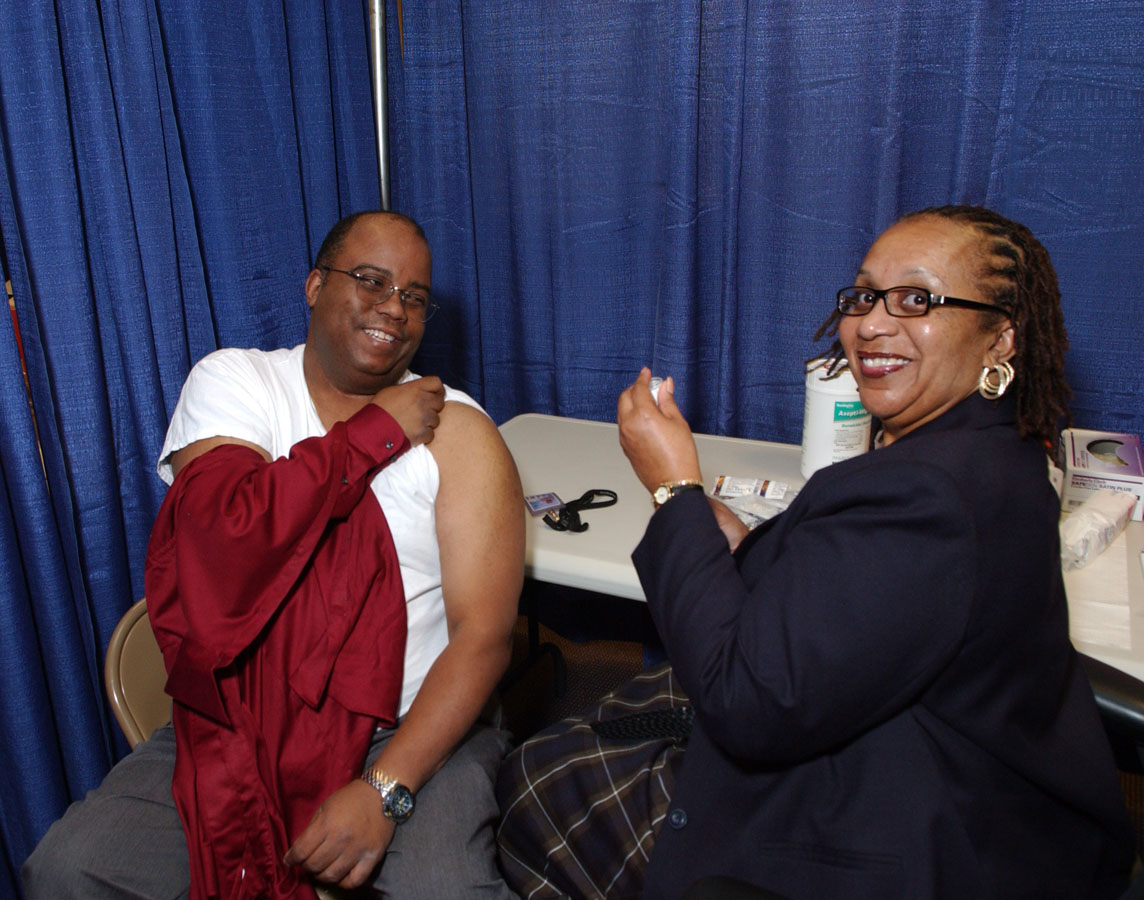 |
Wayne Randolph (left), medical arts, receives his flu vaccine shot from OMS nurse manager Angela Porter.
|
NIH employees turned out in record numbers for their flu shots as part of this year’s Foil the Flucampaign. From Nov. 7 to Dec. 9, employees came to 5NE South—a new, expansive space—to receive their shots and the Occupational Medical Services staff nurses were on hand to help. By the Thanksgiving holiday, 7,584 employees had received their vaccinations at the various clinic locations, including 5NE.
“We received a phenomenal response,” says Angela Michelin, CC Hospital Epidemiology Service, who assists OMS in planning the annual event. “This is the first year we’ve had it in this kind of venue and it turned out very well.”
Employees can receive the flu vaccine through the end of March by calling (301) 496-4411 to schedule an appointment.
Back to Top
Images from gingerbread house decorating contest
 |
2nd Place
(l to r) Ann Marie Matlock, Hastings, Ann Hickey, Samantha Lee-Hendricks, Amy Chi, Debbie Stevens and Cindy Palmer (not pictured) of 5 SE went the rustic route with a pretzel log cabin and barn. “It took a few days to complete,” says Palmer, “but it seemed to be a great hit with everyone who saw it.”
|
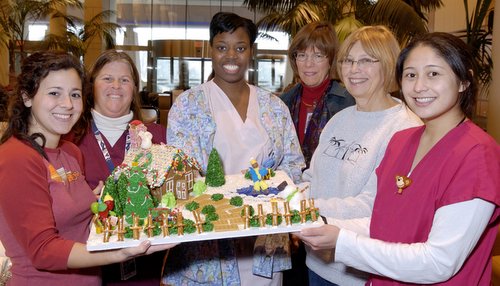 |
3rd place winners are (left to right) Nicole Yanjanin, Ellen Carroll, Christine Spalding, Hastings, Charlotte Bosmans and Ashleigh Hussey of 1 NW, displaying their confectionery artwork, complete with an ice-skating lollipop man. “The trees were made from ice cream cones and Rice Krispies®, which we colored green,” explains Carroll. “Over the course of several days, people would just add things to it as they walked by.”
|
Back to Top
|
|
Clinical Center News, National
Institutes of Health, Building 10, 10 Center Drive, Room 12C440, Bethesda, MD 20892-1504. Tel: 301-496-6787.
Fax: 301-402-2984. Published monthly for CC employees
by the Office of Communications, Patient Recruitment, and Public Liaison. News, article ideas,
calendar events, letters, and photographs are welcome.
Back to Top
|
|


 The information on this page is archived and provided for reference purposes only.
The information on this page is archived and provided for reference purposes only.